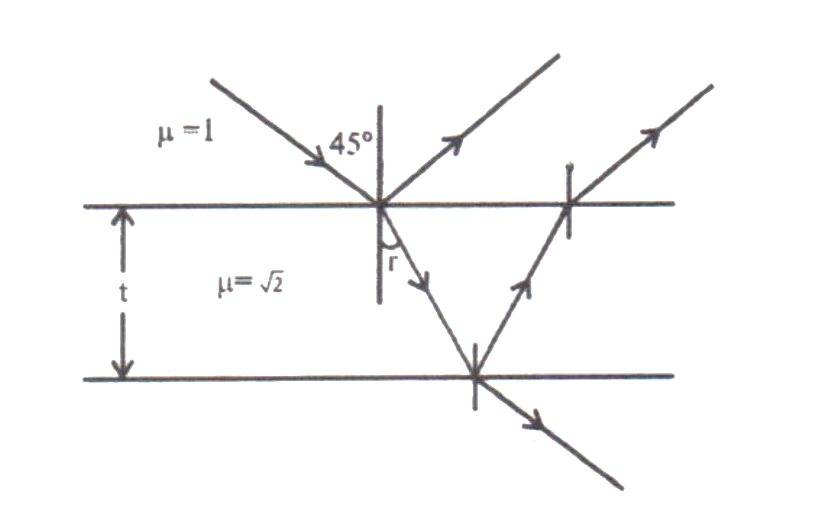Calculate the minimum thickness of a soap bubble film (μ=1.33)that results in constructive interference in the reflected light if the film is illuminated with light whose wavelength in free space is λ=600nm.
To calculate the minimum thickness of a soap bubble film that results in constructive interference in the reflected light, we can follow these steps:
1. Understand the Condition for Constructive Interference:
For a soap bubble, the condition for constructive interference in reflected light is given by the formula:
2μT=n−λ2
where:
- μ is the refractive index of the soap bubble,
- T is the thickness of the soap bubble,
- n is an integer (1, 2, 3,...),
- λ is the wavelength of light in free space.
2. Set the Value of n:
For minimum thickness, we take the smallest value of n, which is n=1.
3. Substitute the Values into the Formula:
Plugging n=1 into the equation gives:
2μT=1−λ2
4. Rearrange the Equation for Thickness T:
Rearranging the equation to solve for T:
T=1−λ22μ
However, since we are looking for the minimum thickness, we can also use the simplified version:
T=λ4μ
5. Substitute the Given Values:
Given:
- λ=600nm=600×10−9m
- μ=1.33
Now substitute these values into the equation:
T=600×10−94×1.33
6. Calculate the Thickness:
Performing the calculation:
T=600×10−95.32≈112.78nm
Final Answer:
The minimum thickness of the soap bubble film is approximately 112.78nm.
---
For a soap bubble, the condition for constructive interference in reflected light is given by the formula:
2μT=n−λ2
where:
- μ is the refractive index of the soap bubble,
- T is the thickness of the soap bubble,
- n is an integer (1, 2, 3,...),
- λ is the wavelength of light in free space.
For minimum thickness, we take the smallest value of n, which is n=1.
Plugging n=1 into the equation gives:
2μT=1−λ2
Rearranging the equation to solve for T:
T=1−λ22μ
However, since we are looking for the minimum thickness, we can also use the simplified version:
T=λ4μ
Given:
- λ=600nm=600×10−9m
- μ=1.33
T=600×10−94×1.33
Performing the calculation:
T=600×10−95.32≈112.78nm
The minimum thickness of the soap bubble film is approximately 112.78nm.
Topper's Solved these Questions
- INTERFERENCE AND DIFFRACTION OF LIGHTBOOK - DC PANDEY ENGLISHCHAPTER - INTERFERENCE AND DIFFRACTION OF LIGHTEXERCISE - Example Type 2
2 Videos
- INTERFERENCE AND DIFFRACTION OF LIGHTBOOK - DC PANDEY ENGLISHCHAPTER - INTERFERENCE AND DIFFRACTION OF LIGHTEXERCISE - Example Type 3
2 Videos
- INTERFERENCE AND DIFFRACTION OF LIGHTBOOK - DC PANDEY ENGLISHCHAPTER - INTERFERENCE AND DIFFRACTION OF LIGHTEXERCISE - Level 2 Subjective
5 Videos
- GRAVITATIONBOOK - DC PANDEY ENGLISHCHAPTER - GRAVITATIONEXERCISE - All Questions
135 Videos
- MAGNETIC FIELD AND FORCESBOOK - DC PANDEY ENGLISHCHAPTER - MAGNETIC FIELD AND FORCESEXERCISE - Medical entrance s gallery
59 Videos
Similar Questions
What is the minimum thickness of a thin film (μ=1.2) that results in constructive interference in the reflected light? If the film is illuminated with light whose wavelength in free space is λ=500nm ?
View SolutionWhat is the minimum thickness of a soap bubble needed for constructive interference in reflected light, if the light incident on the film is 750 nm? Assume that the refractive index for the film is n=1.33
View Solution
Knowledge Check
What is the minimum thickness of a soap bubble needed for constructive interference in reflected light, if the light incident on the film is 750 nm? Assume that the refractive index for the film is n=1.33
A282 nmB70.5 nmC141 nmD387 nm
What is the minimum thickness of thin film required for constructive interference in the reflected light through it ?
(Given, the refractive index of the film =1.5, wavelength of the lilght incident on the film =600 nm.
View SolutionA ray of light is incident at an angle of 45∘ (ralative to the normal) on a thin film of a liquid with an index of refraction of √2. Assuming that the medium of both sides of the film is air, find the minimum thickness of the film required for constructive interference in the reflected light for sodium light of wavelenght 600 nm.

View SolutionAn oil film covers the surface of a small pond. The refractive index of the oil is greater than that of water. At one point on the film, the film has the smallest non-zero thickness for which there will be destructive interference in the reflected light when infrared radiation with wavelength 800 nm is incident normal to the film. When this film is viewed at normal incidence at this same point, for what visible wavelengths, if any, will there be constructive interference? (Visible light has wavelengths between 400nm and 700 nm )
View SolutionRefractive index of a thin soap film of a uniform thickness is 1.38. The smallest thickness of the film that gives an interference maxima in the reflected light when light of wavelength 5520 Å falls at normal incidence is
View SolutionRefractive index of a thin soap film of a uniform thickness is 1.34. Find the smallest thickness of the film that gives in interference maximum in the reflected light when light of wavelength 5360Å fall at normal incidence.
View SolutionFind the minimum thickness of a film which will strongly reflect the light of wavelength 589 nm. The refractive index of the material of the film is 1.25.
View SolutionWhat is the thinnest film of coating with n= 1.42 on glass (n=1.52) for which destructive interference of the red component (650 nm) of an incident white light beam in air can take place by reflection ?
View Solution
